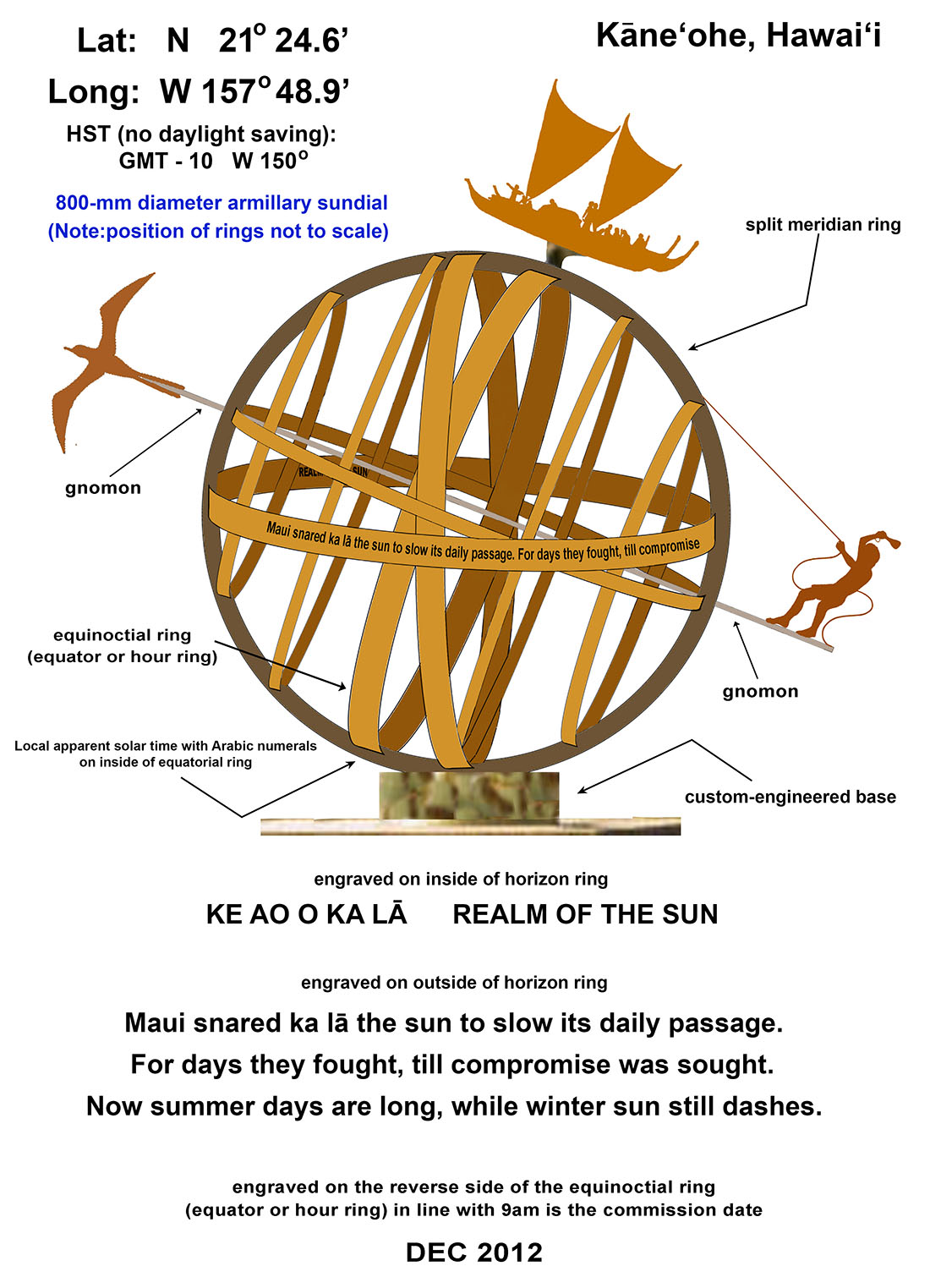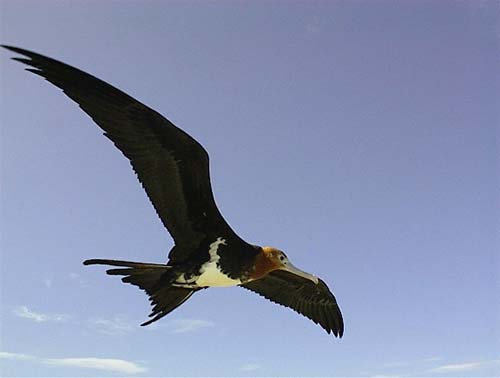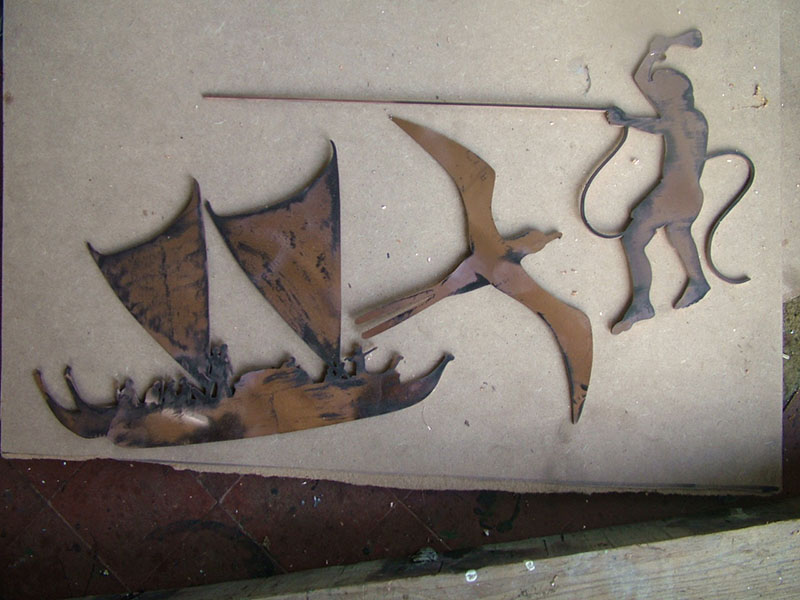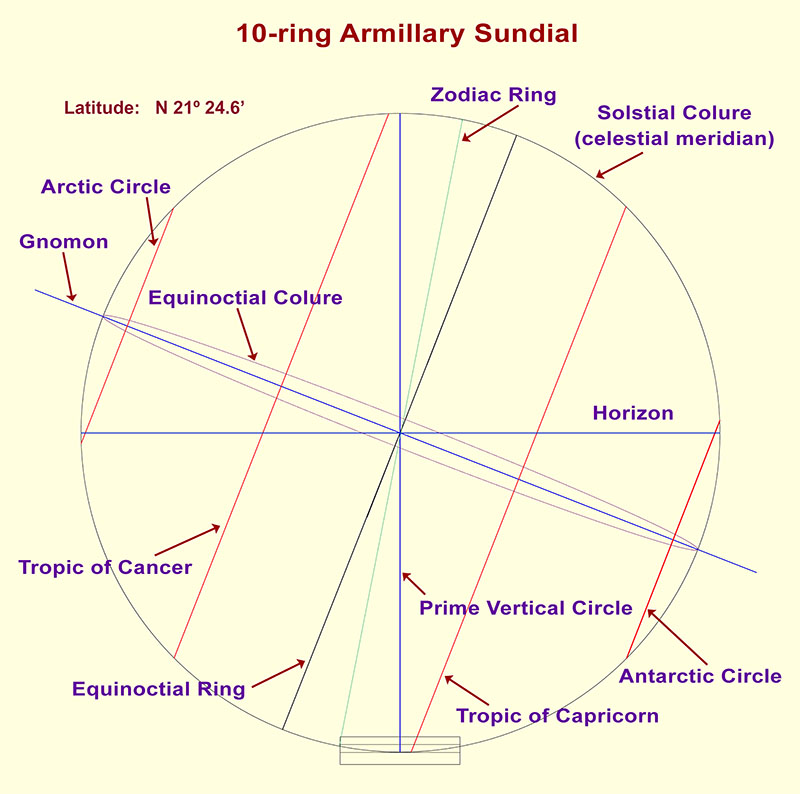This bronze armillary sundial was designed by Joseph Ciotti, director of the Center for Aerospace Education and Hōkūlani Imaginarium at Windward Community College in Kāne‘ohe, Hawai‘i.

The Ke Ao o Ka Lā sundial consists of 10 rings and GNOMON:
The gnomon is the rod that forms the polar axis of the armillary sundial. Its shadow falls onto the inner surface of the Equinoctial Ring (equator) upon which are inscribed the hours. Gnomon comes from a Greek word that means "to know or examine." This is also the root of the English word "know". The gnomon is inclined at the same angle as the latitude of the sundial's location, in this case, 21o 25'.
Polynesian Theme
1. Inscribed on the bronze base plate is the Polynesian Compass (including Western directions)

The Polynesian Compass is divided into directional points (cardinal and secondary) and quadrants:
Cardinal directions:
• ‘Ākau (N): literally "right" when facing due west
• Hikina (E): means "to arrive/come" — stars were believed to come out of holes along the eastern horizon
• Hema (S): literally "left" when facing due west
• Komohana (W): means "to enter" — stars were believed to exit through holes along the western horizon
Four quadrants — named after prominent winds:
• Ko‘olau (NE): northeast tradewinds are the predominant winds that blow across Hawai‘i
• Malanai (SE): gentle breeze associated with the southeast parts of O‘ahu and Kaua‘i
• Kona: (SW): winds that are named for the leeward side of the Hawaiian islands
• Ho‘olua (NW): strong north wind that is generated by storms passing to the north of the Hawaiian islands
Secondary directional points — each quadrant is divided into seven directional points:
• Lā: "sun"
• ‘Āina: "land"
• Noio: "black Noddy bird" that nest along the shoreline in lava tubes and ledges
• Manu: : "bird" — the bird is the traditional metaphor for the Polynesian canoe
• Nalani: "the heavens" — named after Canopus known as Ke ali‘i o kona i ka lewa
• Nā Leo: "the voices" — literally the voices of the stars that speak to the navigator
• Haka: "empty" — refers to the relatively few number of stars in this section of the sky
The Polynesian Compass consists of 32 named directions — the 4 cardinal directions plus the 28 directions in between them. The names for these 28 directions consist of the name of the secondary directional point plus the quadrant name. For example:
• Manu Ko‘olau: NE
• Manu Kona: SE
• Na Leo Ho‘olua: NNW
• Haka Kona: S by W
• ‘Āina Ho‘olua: WNW
• Lā Kona: W by S
2. Poem retelling the legend of Māui snaring the Sun — inscribed around the outside of the horizon ring (written by Joseph Ciotti)
Māui snared ka lā the sun to slow its daily passage.
For days they fought, till compromise was sought.
Now summer days are long, while winter sun still dashes.
3. Three silhouette figures are attached along the meridian circle and gnomon:

- ‘Iwa —the long-winged, forked-tailed frigate or man-of-war bird — positioned at the front of the gnomon. With a wing span up to 6 feet, the ‘iwa can glide on updrafts for days — and typically never stray more than 50 miles from its home island. Sighting an ‘iwa on the open sea is a wayfinding cue to a nearby island. One Hawaiian proverb states: Lele ka ‘iwa malie kai ko‘o — When the frigate bird flies out to sea, the rough sea will grow calm.

- Double-hull Polynesian Voyaging canoe — positioned near the top of the celestial meridian ring (based on the painting Kahai entering Kāne‘ohe Bay by Herb Kane)
- Māui snaring the sun — positioned at the lower end of the gnomon (based on the illustrations of Robin Yoko Burningham for the storybook, How Maui Slowed the Sun by Suelyn Ching Tune)
(bronze water-jet cut silhouettes in workshop of Charlestown Sundials)
Equation of Time (EOT)

The Equation of Time (EOT) is an algorithm which changes Apparent Solar Time (sundial time — that is, what's displayed by the sundial) to Local Time (what's displayed on a clock). In other words, the Equation of Time is the difference between our standard clock time and the time that would be based on the exact position of the Sun in the sky as measured on a sundial.The correction (which is added to the Sundial Time to get the Local Time) adjusts for the facts that:
1. the sundial is not in the middle of its 15o-wide time zone.
2. the earth travels along an elliptical orbit — speeding up when it nears the sun (around January) and slows down when it's farthest from the sun (around July).
3. since the Earth's axis is tilted to its orbit, the Sun's apparent motion along this inclined ecliptic has a varying effect when viewed along the equatorial plane that clocks are reckoned by.
The Hawai‘i Time Zone is centered at longitude W 150o — and technically extends from W 157o 30' to W 142o 30'. At a longitude of W 157o 49', both Honolulu and Kāne‘ohe (island O‘ahu) are technically outside this time zone. This coupled with the seasonal orbital correction means that Local (watch) Time on Oahu is always ahead of Apparent Solar (sundial) Time. As a result, Local (watch) Time in Hawaii is always ahead of Apparent Solar (sundial) Time. For this reason, Hawaii does not observe Daylight Saving Time, since it technically is on perpetual dayling saving time.
According to the EOT for Kāne‘ohe, Local (watch) Time runs between 15 and 45 minutes ahead of Apparent Solar (sundial) time.
How to use the EOT correction:
1. read the sundial time (Apparent Solar Time)
2. look up the correction (in minutes) for the current date
3. add this correction to the sundial time to arrive at the Local (watch) Time
EXAMPLE: on July 1, the correction is 35 minutes. Thus, if the sundial reads 9:10 am, add this correction of 35 minutes to the sundial time to obtain the Local (watch) time of 9:45 am.


